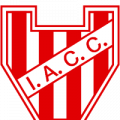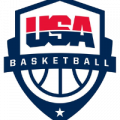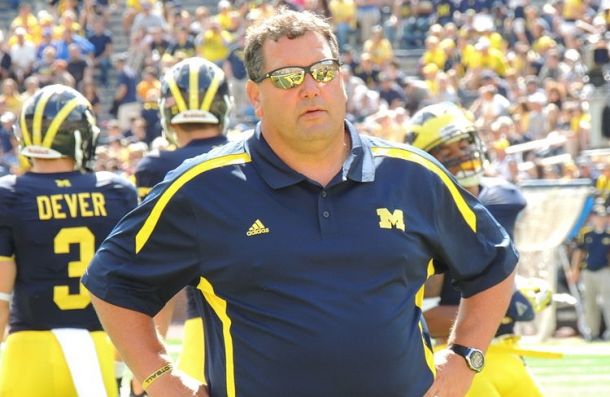Brady Hoke is coming under a lot of pressure as he approaches his fourth season in charge of Michigan. Long gone is the feel good factor he enjoyed after an 11-2 Sugar Bowl winning debut as the replacement for the miscast Rich Rodriguez. In its place resides a feeling of disillusionment, after a misfiring offense led the 2013 Wolverines to a disappointing 7-6 record; the same record that cost Rodriguez his job after the 2010 season.
There are justifications for questioning Hoke, since his impressive 11-2 debut season he has overseen two seasons of decline, with the Wolverines going 8-5 and 7-6 in 2012 and 2013 respectively. Although there was only one win difference between the 2012 and 2013 seasons, they were of a very different nature. In 2012 Michigan were blown out by a powerful Alabama team and crumbled against Nebraska when QB Denard Robinson was knocked out of the game, but kept things close in the other three defeats. In 2013 Michigan struggled to assert their superiority behind a very inconsistent offense right from the start of the season and lost six of the final eight matches in a dismal second half of the 2013 season. They rallied to narrowly lose 42-41 in a classic at the Big House against Ohio State, but that improved performance wasn’t enough to erase the memory of those that had preceded it. The fairly easy 31-14 win for Kansas State in the Buffalo Wild Wings Bowl merely provided confirmation of the malaise that had taken hold in Ann Arbor.
The defense wasn’t faultless, but the primary cause of Michigan’s 2013 problems lay squarely with the offense and it started up-front. Michigan entered the season with returning starters at both tackle positions in Taylor Lewan and Michael Schofield, but breaking in three new starters between them. However, the new look line never settled and no amount of shifting of positions or personnel could create an effective unit. The players just didn’t seem to be ready, which didn’t reflect well upon the offensive line coach, Darrell Funk. The younger players struggled to physically withstand the power of some of the best defensive linemen in college football and there were schematic breakdowns that let pass rushers go unblocked.
The nadir came in East Lansing on November 2nd when they lost 29-6 against Michigan State, as the Spartan defense manhandled Michigan’s offense. The Michigan State defense suffocated quarterback Devin Gardner, sacking him seven times while denying him time on the ball or room to maneuver, and holding Michigan to an embarrassing -48 total rushing yards. Michigan struggled again the following week falling 17-13 at home to a Nebraska team which copied the Spartan game plan, sacking Gardner a further seven times and limiting Michigan to -21 rushing yards. Only Lewan at LT seemed to hold up well in those games and much of the pressure came right through the middle of the line. That’s the worst sort of pressure to give up since it’s the fastest route to the quarterback.
While it is easy, and to an extent justified to place much of the blame on the offensive line, they weren’t exactly helped by the play around them, and the game plan offensive coordinator Al Borges ran wasn’t overly sympathetic to a struggling offensive line. The running backs were given little space to work, but they failed to make the most of the few opportunities they did have, and to a man struggled in pass protection. Gardner's play at QB was erratic, he possesses the arm strength to open up a defense, but was slow to make reads and as a result he frequently held onto the ball too long, playing into the hands of an aggressive pass rush.
The scheme itself lacked creativity, calling for the offensive line to win their individual battles to create space for the playmakers to exploit. When that failed there was too little variety and trickery to create space any other way. The scheme also suffered from a dearth of fast developing plays; there were too few quick passing routes to allow Gardner to get the ball away before the pass rushers could approach him. Working with a dysfunctional offensive line, Al Borges wasn’t dealt an easy hand in 2013, but he’d had three years working with most of the players and should have been able to make a better fist of things than he did. Instead his offense simply wasn’t good enough and it cost him his job.
At 7-6, Hoke's 2013 record matched that of Rodriguez’s final season, however the two seasons that preceded it were far superior to those produced under Rodriguez, who went 3-9, 5-7, and 7-6. In his three year reign in Ann Arbor, Rodriguez finished with a 15-22 record, the worst in the program's history. Hoke, by contrast, is 26-13 after three seasons, and perhaps most importantly is not Rodriguez. The Rodriguez regime was the first in the programs history to be accused of and found guilty of major NCAA rules violations. Rodriguez's time in charge also saw an unusually high rate of scholarship player attrition, which is rarely the sign of a healthy program. Rodriguez also brought a new style of football to Ann Arbor, installing his up-tempo, exotic and highly effective spread offense; it could be great to look but it wasn’t exactly “Michigan football." This isn’t intended as a character assassination upon Rich Rodriguez, he is a terrific college coach who produces an exciting brand of football, but he was always a poor fit for Michigan.
Hoke on the other hand is a great fit, he occupied various coaching roles at Michigan from 1995 through to 2002, he knows the program well and under him there has been an emphasis placed upon a return to the traditional values associated with the Michigan program. That has been reflected in a focus on recruiting talented pro-style players, players of seemingly high character and who feel a strong bond with the program. It has resulted in an increased rate of player retention. Of the twenty five players in the 2012 recruiting class, the first entirely recruited under Hoke, only Kaleb Ringer has left for greener pastures. Recruiting as a whole has blossomed under the Hoke regime, led by defensive coordinator Greg Mattison and Hoke himself. They have landed strong class after strong class, replenishing the roster. It wasn’t that Rodriguez had left a squad bereft of talent, there were genuine stars such as Denard Robinson in the squad, but the depth simply wasn’t good enough.
Hoke has also attempted to bring back a more traditional style of play to Ann Arbor. That appears to be an ongoing process, having been hobbled by inheriting a roster ill-suited to a pro-style offense along with one of the worst defenses in the country. It has taken time to rebuild the squad with the necessary size, power, and athleticism to excel, a process that should be reaching fruition over the next two seasons. He has turned the program around off the field, making it resemble the Michigan program of old, but Hoke’s performance will ultimately be judged by the product on the field, which to date just hasn’t been good enough.
Had Hoke remained stubborn in his support of Borges then he would have been squarely on the hot seat for the 2014 season. Instead, Hoke recognized that change was necessary; hiring Doug Nussmeier away from Alabama as Al Borges replacement was a shrewd move. Nussmeier was a productive offensive coordinator at Alabama and at Washington before that. He is also a strong stylistic fit for what Hoke wants. If he can coax some consistency out of Gardner at QB, and if he and Coach Funk can get the offensive line to play to an acceptable level, there is enough talent around them to form an effective offense in 2014. So long as Michigan avoid having a complete disaster in 2014, Hoke should remain in charge for the 2015 season. By then all the key positions will be occupied by players he has recruited, the schedule will look favorable, and it will be time for Hoke to prove he has what it takes to return Michigan to the top.





































